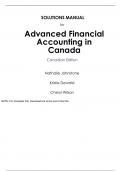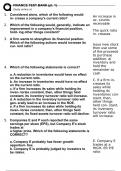SOLUTIONS MANUAL for Advanced Financial Accounting in Canada Canadian Edition Nathalie Johnstone Kristie Dewald Cheryl Wilson NOTE: For Complete File, Download link at the end of this File Chapter 1 Introduction to Advanced Financial Accounting Review Questions 1-1. Arguments for classification as a passive investment: Delta only owns 15% of the voting
shares of Epsilon. The remaining shares are held by one company, indicating that Delta may not have influence. Arguments for classification as an associate: Typically, a shareholding of 20% or more is indicative of significant influence. However, this fac tor is not definitive. Other factors should also be considered to determine whether or not significant influence exists. In this case, Delta Corporation can elect one member of the board of directors, indicating that there is some influence over the polici es of Epsilon. Delta also possesses a patent that Epsilon needs in its operations, which it allows Epsilon to use. This patent further indicates that there is significant influence. Conclusion: Based on the information provided, the investment in Epsilon s hould be classified as an associate and Delta Corporation should use the equity method to account for its investment. 1-2. IFRS 10 outlines the three criteria that must be present for control to exist. They are the
power criterion, return criterion, and th e link between the two. The power criterion refers to the ability of an investor to direct the relevant activities of the investee. The return criterion refers to the risks and rewards associated with the earnings of the investee. The link between the firs t two criteria is the ability to use its power to affect the earnings of the investee. 1-3. Factors that should be considered in determining control include:
1.Voting rights along with convertible rights.
2.Right to choose key personnel, such as the board of directors or key management.
3.The right to veto key decision of the investee or right to force the investee to enter into a
specific transaction.
4.Material transactions with the investee.
5.Exchange of management or technology.
1-4. Factors used to determine if an investor has significant influence are presented in IAS 28:
1.Voting rights of 20% to less than 50% is usually considered enough to give the investor
significant influence.
2.Other factors to consider are:
-representation on the board of directors, but not enough to control the board
-ability to share in determining the policies of the investee
1-1 ISM for Johnstone/Dewald/Wilson, Advanced Financial Accounting in Canada , Canadian Edition Copyright © 2023 Pearson Canada Inc. 1-2-material intercompany transactions
-exchange of management or technical information
1-5. IFRS 10 refers to the parent as an entity that controls another company, which is referred to
as the subsidiary. The parent -subsidiary relationship exists when one company controls another entity. 1-6. Strategic investments are investments that are closel y linked to the strategic goal of the
investor. Traditionally, these types of investments help the investor improve or meet its organizational goals. There are three classifications for strategic investments: associates, subsidiaries, and joint arrangements. 1-7. A joint arrangement is defined in IFRS 11 as an agreement between two or more investors
where they share control over an operation. There are two types of joint arrangements: joint ventures and joint operations. Chapter 1: Introduction to Advanced Financial Accounting Copyright © 2023 Pearson Canada Inc. 1-3 Case 1 -3 Heavenly Hakka Inc., Nature’s Harvest, and Premier Inc. Situation A – Heavenly Hakka Inc. Objectives of Financial Reporting Heavenly Hakka Inc. (HH) is a private company given that Vincent is its sole owner. Therefore, with Vincent’s consent, HH can choose to use Accounting Standards for Private Enterprises (ASPE) to report its investment in Szechwan Samosas Inc. (SSI). Analys is of the Case Scenario and Appropriate Accounting Alternative(s) HH, Ibrahim, and Venkat each own 1/3 of the shares of SSI. However, HH is entitled to 40% of the profits of SS, given Vincent’s involvement. Lately, however, because of differences among Vincent and the other two owners relating to expansion of the operations of SSI beyond Ontario, Vincent has not been visiting the premises of SSI. The case is not clear on how this is going to affect the profit -sharing agreement. Further, the case is also not clear on why HH is being compensated for Vincent’s time spent on the operations of SSI via a larger share of the profits of SSI instead of via a management fe e. Any management fees paid by SSI to HH for Vincent’s time would, for tax purposes, constitute an expense to SSI. Further, paying for Vincent’s time via a management fee is a more accurate reflection of the underlying economic reality. It is not clear fr om the facts of the case whether the three owners have joint control over SSI. The incorporation documents and any other agreements that may exist between the three owners of SSI have to be reviewed to obtain further details on this point. Nevertheless, th e facts in the case clearly indicate that HH does not possess sole control of SSI. While HH is the sole supplier of the fillings that go into the samosas of SSI, that fact by itself is not indicative of control of SSI by HH. At most, it indicates that HH has significant influence over SSI. Further, HH does not have the power to direct the activities of SSI without the cooperation of the other two shareholders. Thus, the facts in the case suggest that HH either has joint control over or can significantly influence SSI. Recently, however, differences have arisen among Vincent and the other two shareholders of SSI. If incorporation documents or other agreements among the shareholders of SSI exist evidencing joint control, such control will not be affected by the recent differences between the shareholders. On the other hand, if such documents or agreements do not exist, the other two shareholders could, based on their combined 2/3 ownership of SSI, theoretically join togeth er to prevent HH from having any influence over SSI. However, that seems unlikely given that HH is the sole supplier of the fillings that go into the samosas of SSI. Thus, the recent differences between the shareholders most probably will not affect any si gnificant influence that HH has over SSI. Thus, HH should account for its investment in SSI either as a joint venture or as an investment over which it has significant influence. If HH decides not to use International Financial Reporting Standards (IFRS), then it should use the equity basis to report its investment in SSI. Alternatively, if HH opts to use ASPE, it can use the cost basis to report its investment in SSI.





